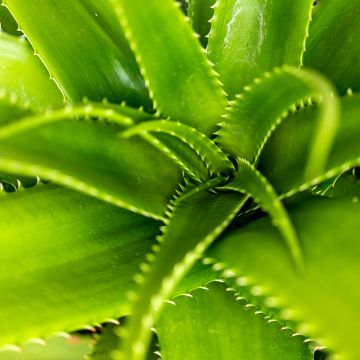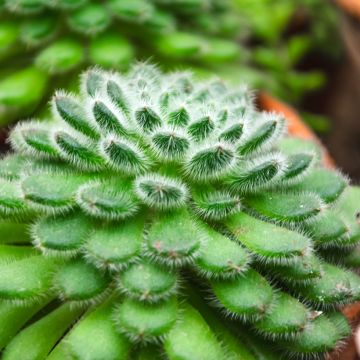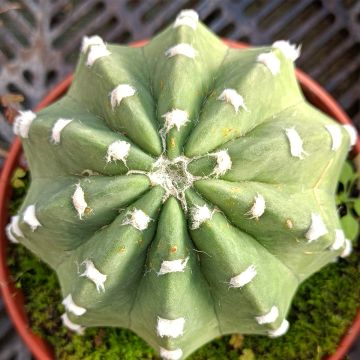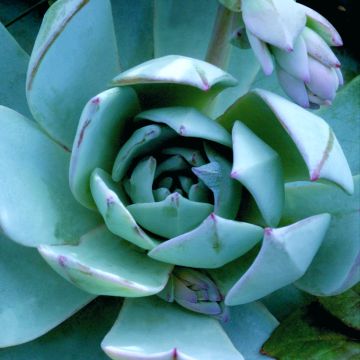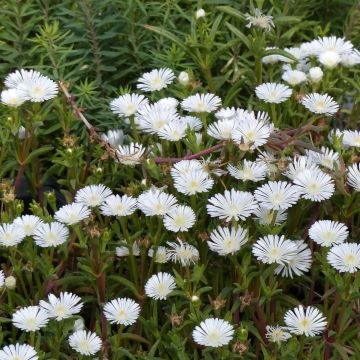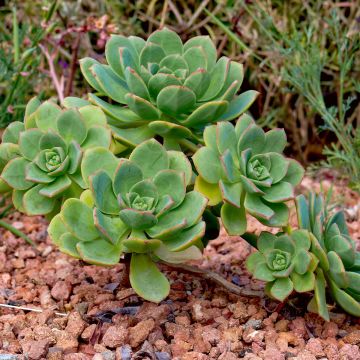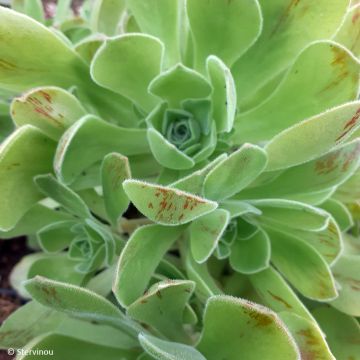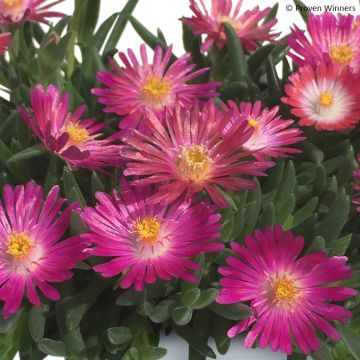

Portulacaria afra Variegata
Portulacaria afra Variegata
Portulacaria afra Variegata
Elephant Bush, Spekboom, Purslane Tree
This item cannot be shipped to the selected country
Delivery charge from €5.90
More information
Schedule delivery date,
and select date in basket
This plant carries a 12 months recovery warranty
More information
We guarantee the quality of our plants for a full growing cycle, and will replace at our expense any plant that fails to recover under normal climatic and planting conditions.
From €5.90 for pickup delivery and €6.90 for home delivery
Express home delivery from €8.90.
Does this plant fit my garden?
Set up your Plantfit profile →
Description
Portulacaria afra 'Variegata' is a succulent shrub with a bonsai-like appearance, distinguishing itself from the type species by its trailing habit and light green foliage variegated with cream, making it a stunning addition to hanging baskets. This long-lived perennial develops well-branched stems of a reddish-brown colour that enhance the bright colouration of its fleshy leaves. It is a variety with reduced growth, slow and easy to maintain, mainly suitable for indoor cultivation due to its low hardiness.
Portulacaria afra 'Variegata' belongs to the same family as purslanes, the Portulacaceae. It is a succulent shrub native to southeastern Africa, capable of reaching a height of 4 m (13 ft) and living up to 50 years. Sometimes called "purslane tree", it is more often confused with the jade plant or Crassula ovata because it also resembles a dwarf tree, but with much thinner and smaller leaves. It is an ornamental plant that is often cultivated as hedges and topiaries in warm climates, but its foliage constitutes 80% of the diet of elephants in South Africa. It tolerates direct sunlight but thrives better under strong indirect light. It is a plant that enjoys full light and is relatively resistant to drought, but it also appreciates a bit of freshness, especially during the growth period. Being perfectly tolerant of pruning, it is mainly cultivated as a bonsai, in a pot under a greenhouse, in a conservatory, or indoors, as it loses its foliage at temperatures below -2 °C (28.4 °F).
Portulacaria afra 'Variegata' is a cultivar that distinguishes itself from the type species by its prostrate habit, variegated cream foliage, and less vigorous growth. It has a trunk and succulent, thick, and stout stems with a very decorative reddish-brown bark that exfoliates and turns grey-brown with age. Slow-growing, it eventually forms a clump 2 m (7 ft) tall and 1 m (3 ft) wide. Its branched clump bears fleshy, obovate to rounded leaves, without petioles, measuring 1 to 3 cm (0.4 to 1 in) in diameter, light green with cream margins. In its natural habitat, this plant blooms after the spring rains from May to June, with terminal clusters of very pale pink flowers edged in dark pink, similar in shape to its foliage below, but very rare in our climates.
Frost-sensitive, Portulacaria afra 'Variegata' should be planted in a pot that will be stored away at the arrival of the first cold weather and kept dry until the vegetation resumes in spring. It can be combined with other succulent plants such as sedums, purslanes, and Echeverias to create miniature dry gardens, or placed in a large pot on a veranda or window sill.
Report an error about the product description
Portulacaria afra Variegata in pictures
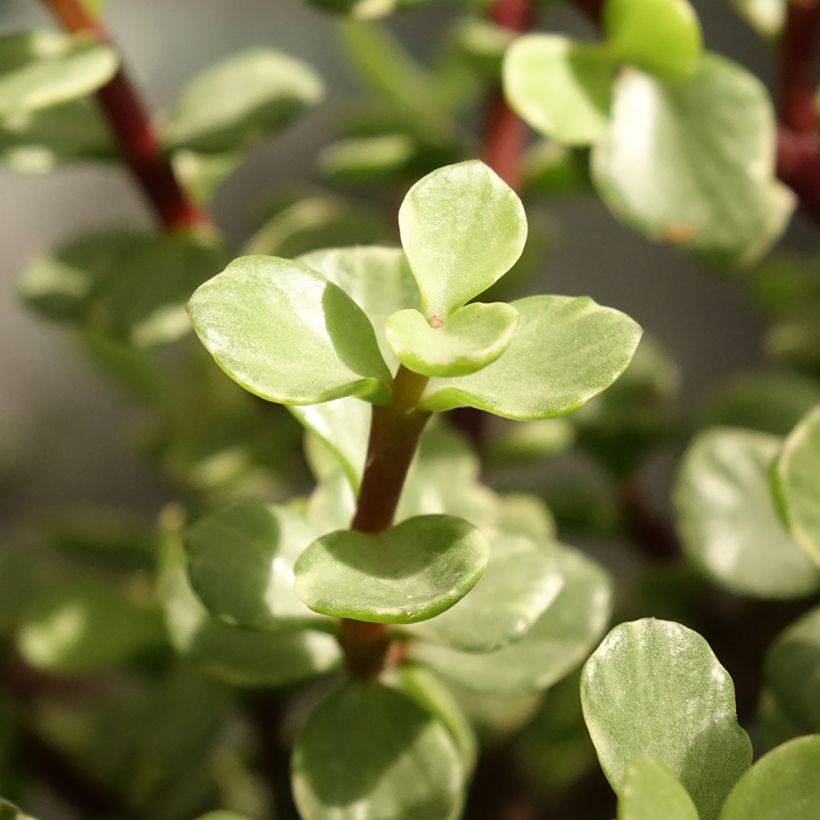

Flowering
Foliage
Plant habit
Botanical data
Portulacaria
afra
Variegata
Portulacaceae
Elephant Bush, Spekboom, Purslane Tree
South Africa
Other Cacti and succulents
Planting and care
Plant Portulacaria afra 'Variegata' in full sun or partial shade in a light, well-draining, mineral-rich soil that is sandy to rocky. However, it thrives best in bright but indirect light, where it will develop larger leaves. Not hardy, it does not tolerate temperatures below -2 °C (28.4 °F) and loses its leaves around 5 °C (41 °F). Grow it in a pot with a succulent mix, keeping it dry throughout the winter in a bright room at temperatures between 8 and 10 °C (46.4 and 50 °F). Excess moisture in winter can greatly reduce the hardiness of this plant. Water from April to October, allowing the substrate to dry between waterings.
Planting period
Intended location
Care
This item has not been reviewed yet - be the first to leave a review about it.
Haven't found what you were looking for?
Hardiness is the lowest winter temperature a plant can endure without suffering serious damage or even dying. However, hardiness is affected by location (a sheltered area, such as a patio), protection (winter cover) and soil type (hardiness is improved by well-drained soil).

Photo Sharing Terms & Conditions
In order to encourage gardeners to interact and share their experiences, Promesse de fleurs offers various media enabling content to be uploaded onto its Site - in particular via the ‘Photo sharing’ module.
The User agrees to refrain from:
- Posting any content that is illegal, prejudicial, insulting, racist, inciteful to hatred, revisionist, contrary to public decency, that infringes on privacy or on the privacy rights of third parties, in particular the publicity rights of persons and goods, intellectual property rights, or the right to privacy.
- Submitting content on behalf of a third party;
- Impersonate the identity of a third party and/or publish any personal information about a third party;
In general, the User undertakes to refrain from any unethical behaviour.
All Content (in particular text, comments, files, images, photos, videos, creative works, etc.), which may be subject to property or intellectual property rights, image or other private rights, shall remain the property of the User, subject to the limited rights granted by the terms of the licence granted by Promesse de fleurs as stated below. Users are at liberty to publish or not to publish such Content on the Site, notably via the ‘Photo Sharing’ facility, and accept that this Content shall be made public and freely accessible, notably on the Internet.
Users further acknowledge, undertake to have ,and guarantee that they hold all necessary rights and permissions to publish such material on the Site, in particular with regard to the legislation in force pertaining to any privacy, property, intellectual property, image, or contractual rights, or rights of any other nature. By publishing such Content on the Site, Users acknowledge accepting full liability as publishers of the Content within the meaning of the law, and grant Promesse de fleurs, free of charge, an inclusive, worldwide licence for the said Content for the entire duration of its publication, including all reproduction, representation, up/downloading, displaying, performing, transmission, and storage rights.
Users also grant permission for their name to be linked to the Content and accept that this link may not always be made available.
By engaging in posting material, Users consent to their Content becoming automatically accessible on the Internet, in particular on other sites and/or blogs and/or web pages of the Promesse de fleurs site, including in particular social pages and the Promesse de fleurs catalogue.
Users may secure the removal of entrusted content free of charge by issuing a simple request via our contact form.
The flowering period indicated on our website applies to countries and regions located in USDA zone 8 (France, the United Kingdom, Ireland, the Netherlands, etc.)
It will vary according to where you live:
- In zones 9 to 10 (Italy, Spain, Greece, etc.), flowering will occur about 2 to 4 weeks earlier.
- In zones 6 to 7 (Germany, Poland, Slovenia, and lower mountainous regions), flowering will be delayed by 2 to 3 weeks.
- In zone 5 (Central Europe, Scandinavia), blooming will be delayed by 3 to 5 weeks.
In temperate climates, pruning of spring-flowering shrubs (forsythia, spireas, etc.) should be done just after flowering.
Pruning of summer-flowering shrubs (Indian Lilac, Perovskia, etc.) can be done in winter or spring.
In cold regions as well as with frost-sensitive plants, avoid pruning too early when severe frosts may still occur.
The planting period indicated on our website applies to countries and regions located in USDA zone 8 (France, United Kingdom, Ireland, Netherlands).
It will vary according to where you live:
- In Mediterranean zones (Marseille, Madrid, Milan, etc.), autumn and winter are the best planting periods.
- In continental zones (Strasbourg, Munich, Vienna, etc.), delay planting by 2 to 3 weeks in spring and bring it forward by 2 to 4 weeks in autumn.
- In mountainous regions (the Alps, Pyrenees, Carpathians, etc.), it is best to plant in late spring (May-June) or late summer (August-September).
The harvesting period indicated on our website applies to countries and regions in USDA zone 8 (France, England, Ireland, the Netherlands).
In colder areas (Scandinavia, Poland, Austria...) fruit and vegetable harvests are likely to be delayed by 3-4 weeks.
In warmer areas (Italy, Spain, Greece, etc.), harvesting will probably take place earlier, depending on weather conditions.
The sowing periods indicated on our website apply to countries and regions within USDA Zone 8 (France, UK, Ireland, Netherlands).
In colder areas (Scandinavia, Poland, Austria...), delay any outdoor sowing by 3-4 weeks, or sow under glass.
In warmer climes (Italy, Spain, Greece, etc.), bring outdoor sowing forward by a few weeks.

































